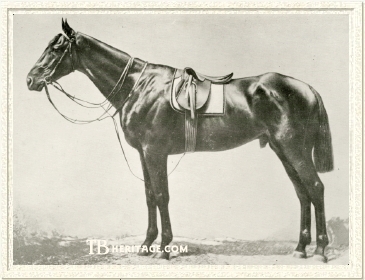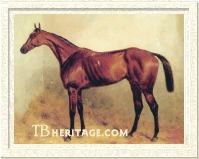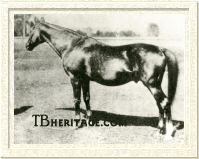|
|
Gladiateur

|
|
 |
|
|
One of the best horses ever to grace the turf in any century, was GLADIATEUR, from the Gladiator daughter, Miss Gladiator, and by Monarque. Born in 1854, Miss Gladiator was out of Taffrail by Sheet Anchor, bred at Thomas Carter's stud in Vineuil. She won once, the Prix de l'Ecole Militarie, and injuring her leg, was retired to the breeding shed, having been purchased by the Comte de Lagrange because of her Gladiator blood. She dropped a filly, Fille-des-Jones by Peu d'Espoir, 1858; and a second daughter, Villa-franca in 1860 by Monarque in 1860. She was sent back to Monarque in 1861, and produced the dark bay colt Gladiateur in the spring of 1862. Miss Gladiator produced a colt, Imperator, in 1864, by Monarque or Father Thames, and an unnamed colt by Monarque in 1865, her last recorded foal. None but Gladiateur did anything on the turf.
Gladiateur was a particularly large foal, with, it was reported by French writers, superb symmetry. A later English turf writer, possibly after he had trounced British horses on their own turf to take the English Triple Crown, described him as "a rough-looking, angular horse, without any quality." It was agreed he was tall: "amongst his Derby competitors, he stood out like a giant in the midst of pigmies." A later English turf writer said he had "strength, grace, sweetness and courage."
LeGrange deliberately held off on training Gladiateur; he had nominated him to both the French and English classics soon after he was born, and the count was determined to proceed slowly with the overgrown youngster. In addition, Gladiateur had an enlarged left foreleg from a paddock accident as a youngster, and, although this flaw did not cause him much grief, he did suffer from navicular, and was periodically unsound throughout his career. Gladiateur wasn't started until well into his two year old year, and his first race, in England, under the schooling of Tom Jennings at Newmarket, was in the fall. He won his first event, the Clearwell Stakes at Newmarket, beating Pantaloon and ten others. He dead-heated for third in his next race, the Prendergast Stakes, against a better field, and failed to place in the Criterion. It was a modest beginning. |

Gladiateur depicted by Harry Hall | | At age three, "The Avenger of Waterloo" started his season by running in the 2,000 Guineas, winning by a neck in a thrilling four-horse race in the home stretch. He followed that with the Derby, coming from behind to win by two lengths. Shipped back to France to run in the Grand Prix de Paris, he was greeted by a wildly cheering crowd of over 100,000. In the Grand Prix de Paris he put his French-bred opponents away by three lengths, including that year's winner of the Prix du Jockey Club.
|
Brought back to England, he ran in Goodwood's Drawing Room Stakes, which he won, followed by a walk-over in the Bentinck Memorial Stakes. The next race was an easy three-length victory, despite being lame, in the Doncaster St. Leger, adding the last jewel to the English Triple Crown, the second horse to win all three classic races. He followed that up by winning the Doncaster Stakes by three lengths. Sent back to France, he won the Prix du Prince Imperial (later the French St. Leger), beating his sole opponent, Vertugadin. Back at Newmarket in October, he won the Newmarket Derby by forty lengths over his sole opponent, Longdown. His winning streak ended when he failed to place in the Cambridgeshire against older horses in heavy going over a distance that did not suit his come-from-behind style of racing, particularly with his near-sighted jockey Harry Grimshaw, and penalized by the heaviest weight, carrying 9 st. 12 lbs. It was won by the Vedette filly Gardevisure. He was then returned to winter quarters in France.
Gladiateur wasn't through, however. At age four he started the season with two walk-overs: the Derby Trial Stakes and the Claret Stakes. He followed that up by winning the Ascot Gold Cup by forty lengths from his two opponents, having come from 300 yards behind the front runner. Back in France, he won the Grand Prix de l'Imperatrice , the Gold Cup at Paris in April, and the four-mile Grand Prix de l'Empereur at Paris in October.
Gladiateur in the Stud
Having won convincingly at all distances over a mile, the French-bred champion of England's most prestigious races and its Triple Crown, was retired to the count's stud, where he proved a disappointment. He had been at stud only four years when France was invaded in 1870 during the Franco-Prussian war: Chantilly was occupied by Germans, and Longchamp completely destroyed. Many French studs sent their horses to the south of France, and to Belgium, but primarily to England, where a number were sold at Tattersalls. The Comte de Legrange's stud was disbanded at this time. Some were sold as a group to C.J. Lefevre and were sent to his stud at Dangu. Another large group--thirty-nine-- was shipped to England for sale at Tattersalls on September 3, 1870. Gladiateur was among those sold in England, purchased by William Blenkiron (Jr.) of the Middle Park Stud for 152,250 francs. Suffering severely from navicular disease, he was put down in 1876, a champion without a single meritorious successor on the turf, and nothing in Europe or England that was able to continue his sire line.
|

Grandmaster | | His most successful sire son by far was GRANDMASTER (1868, from Celerima by Stockwell), who never ran in England, having been sold as a yearling to Danger and White, an Australian partnership, and shipped to Australia, where he was entered in the International Exhibition at Sydney and adjuged the "best-conformed" two year colt. His offspring in Australia met with great success, and one, the gelded Paris, a dual winner of the 12 furlong Caufield Cup and other distance races, was even shipped to England to win handicaps there under big weights.
|
Grandmaster was able to get both high class sprinters and stayers, among them Sting (3 mile Randwick Plate, Adelaide Cup); Espiegle and Folly (both won the 8 furlong A.J.C. Epsom Handicap); V.R.C. Australian Cup winner Highborn; the versatile gelding Bungebah (winner of stakes from 6 to 12 furlongs); the gelded Stanley, winner of the 13 furlong Adelaide Cup; A.J.C. Derby and V.R.C. St Leger winner Gibralter; and Ensign, who beat Carbine in the 12 furlong V.R.C. Derby. Grandmaster was also a superior broodmare sire. One of his daughters, Colors, produced four outstanding winners in Australian Star (Caufield and Eclipse Stakes), Australian Colors (14 furlong Alderman Cup), Tartan (many top distance races, including Sydney Cup, A.J.C. Plate, V.R.C. Champion Stakes, Randwick Plate etc.) and All Green (Queensland Cup). Many of his other daughters were excellent broodmares of top winners. His daughter Grand Lady was fourth dam of the good American runner Double Jay (1944).
LORD GOUGH (1869), in James Daly's stud in Ireland was a source of stamina and influential in steeplechasing. He was out of Battaglia, by Rataplan. His daughter, Daisy (1892), produced Grand National Steeplechase winner Eremon and Christmas Daisy, two-time winner of the Cambrdigeshire Handicap. Another daughter, Kooinur (1881), produced Irish Oaks winner Marievale and other daughters whose descendants produced winners in Czechoslovakia and Brazil. Lady Gough (1888) produced good winners in Daly's stud, and Countess Gough (1885) was second dam of Doncaster Cup winner Willlbrook. His most influential daughter was Hasty Girl (1875, out of Irritation by King of Trumps), who was the dam of the good runner and sire Bendigo (Cambridgeshire, Champion Stakes, Eclipse Stakes); she was also dam of St. Leger winner Kilwarlin, and her daughter Bellinzona bred on.
Gladiateur's son HIGHBORN (1870, from the good winner Fille de l'Air) had some good progeny, most notably the 1876 filly Dresden China (from Fortress by Citadel), winner of the Doncaster Cup, the Great Yorkshire Handicap and the Goodwood Cup. Another one of his winners was Manchester November Handicap winner Parlington.
Of Gladiateur's other sons, there were few successes on the turf on in the stud. IL GLADIATORE (1874, from Scottish Queen) won the Ebor Handicap, and later had a few offspring. LYDON (1868), winner of the Liverpool Spring Cup in 1873, got a filly named Tebro in 1877 (in-bred to Tomyris by Sesotris); she became the dam of three top winners in Poland. KREMLIN (1870) got Kordjan, winner of the Nagroda Derby in Russia, and later a sire whose son, Count Grabowski, and grandson, Kordecki, were also winners of that race. MATADOR (1872), shipped to the U.S., got the filly Madcap, who was second dam of Withers Stakes winner Kilmarnock, also a winner fo the Queen Alexandra Stakes in England and the Prix du Conseil Municipal in France.
Gladiateur's daughters were moderately successful in the breeding shed, and can be seen in the pedigrees of distant tail-female descendants, some of which were classic winners. FAIR MAID OF KENT (1868) produced Grand National Steeplechase winner Frigate (1878, by Gunboat), a great mare that won multiple chases and hurdles; Fair Maid of Kent was also the dam of Irish Derby winner Kentish Fire (1997 by Torpedo). KEAPSAKE (1873) was second dam of French Oaks winner Kasbah, in turn dam of the great race mare Kizil Kourgan (Grand Prix de Paris and French Oaks), the latter later dam of Ksar and Kenilworth. PRETENCE (1872, from Chevisaunce by Stockwell) was the dam of Ascot Gold Vase winner Ambassadress, and tail-female ancestress of Italian Derby winner Pilade and Arc winner Crampon, as well as classic winners in Argentina. LADY EMILY (1874) became the second dam of classic winners in Poland around the turn of the century. NIXETTE (1871) from the French Oaks winner Deliane became the second dam of stakes winners in Russia. MISS LUCY (1869) was dam of Criterion Stakes winner Monsieur Philippe, and a daughter, Lucetta, was the dam of a good winner of French races in Lieutel.
--Patricia Erigero
|
|
|
|

